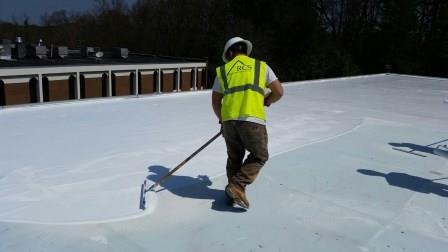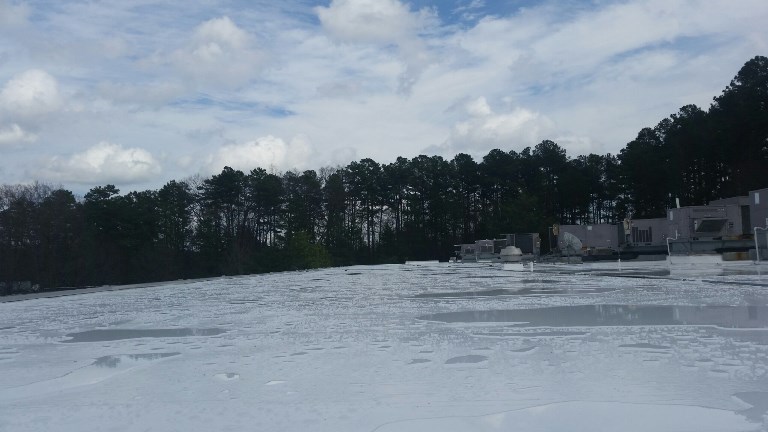A water-tight roof deck is one of the most important aspects of facility maintenance, so when Grubb Ventures, owner of an upscale office building in Raleigh, N.C., noticed that the roof was in need of some TLC, they were quick to act. They contracted with Coating Technologies, a division of Roof Control Services, to come in and coat the 70,000-square-foot (6,503.2 m²) roof deck with GE’s SCM 3500, a high-solids silicone coating.
According to Fred Wolfe, principal consultant for 5 Prime Coatings, a consulting firm that works closely with Coating Technologies, this particular coating was chosen not only for its long-term durability and ultraviolet (UV) resistance but also for its ability to adhere to single-ply membranes without the application of a primer. “We wanted to use a coating system that has excellent resistance to weathering but also can go down in one coat. The GE SCM 3500 was a great choice for this roof project,” stated Wolfe.
When the six-person Coating Technologies crew arrived on the scene to scope out the condition of the roof, they found an aging single-ply system over two inches (5.1 cm) of polyisocyanaturate insulation, a vapor retarder, and the metal deck. According to Wolfe, the single ply was in bad shape in some areas. “In certain places, the waterproofing membrane was worn away. In addition, the roof was leaking in some locations,” he said. The team also had to deal with air conditioning units that were surrounded by “spaghetti” mats that had been adhered to the existing membrane. “These mats were brittle from age and exposure to the elements. Since they were completely falling apart, they had to be removed before any coating application could begin,” stated Wolfe.
Gaining Access
As there was no exterior access to the roof deck, the Coatings Technologies crew had to enter the building to gain entry to the roof. “Extra care had to be taken not to track wet coating on the carpet of the upscale office building. In addition, the offices below had many tenants, so we had to be careful about not disturbing them,” explained Wolfe. The crew wore booties over their boots and exercised extreme caution to keep all surfaces of the building’s interior clean and free of debris.
Although the crew had to go through the interior of the building to access the roof deck, the equipment and materials needed for the job had a different route to the top. “The team used a very handy Paus roofing material elevator to load the coating material and equipment on the roof deck. This elevator has a telescoping arm that can reach up to 150 feet [45.7 m] in the air and hold up to 800 pounds [362.9 kg] in one load. Not only was using the Paus material elevator a huge timesaver, but it also saved the client the expense of renting a crane,” said Wolfe.
While on the roof, the crew was equipped with all necessary personal protective equipment (PPE), including hard hats, safety vests, safety glasses, steel-toed boots, and gloves. “We roped off the perimeter of the building and used retractable harnesses and AES Raptor fall protection systems. The crew was tied off at all times when within six feet [1.8 m] of the edge of the building,” stated Wolfe.

Keeping the Work on the Roof
The team began the surface prep process by tearing off the crumbling spaghetti mats, most of which crumbled as they were pulled up. “It was helpful to use two men — one to pull up the mats and another to carefully scoop up the fragments left on the roof,” said Wolfe. Next, the crew sprayed the roof down with a mixture of water, industrial detergent, and an environmentally friendly algaecide using Generac pressure washing systems. The roof was thoroughly scrubbed with brushes and industrial surface cleaners, run from the pressure washer pumps. The entire roof deck was then rinsed with plain water from a pressure washer.
As stated by Wolfe, containment was not necessary, as the detergent that was used is biodegradable and not harmful to the environment; however, the team had to practice extreme caution when cleaning the roof. “There was a parking lot full of cars very close to the building, so the crew needed to keep their work on the roof. In other words, no overspray was allowed,” said Wolfe.
Time for the Main Event
After the entire roof area was cleaned, it was inspected once and all areas that required repairs were patched with GE’s Momentus silicone and a polyester fabric. “The silicone and polyester fabric were also installed around all curbs, penetrations, drains, and angle changes. Several dormant pipe stacks were removed, and those areas were repaired with EternaBond roof repair tape,” stated Wolfe.
The crew then cut in the perimeter of the roof with the GE SCM 3500 silicone using brushes. To ensure a proper coverage rate, 100-square-foot (9.3 m²) areas were marked out with chalk. The silicone coating was poured onto the area, and a notched squeegee was used to pull the coating out to the proper thickness. Then, an 18-inch (45.7 cm) roller with a 3/8-inch (1 cm) nap was used to backroll the coating to ensure smooth and even coverage. This was repeated until the entire roof received a single coat of silicone. “A final inspection was completed to determine the final DFT [dry film thickness] with a non-destructive meter. The field coating averaged 54 mils [1,371.6 microns] and the flashings averaged 94 mils [2,387.6 microns],” revealed Wolfe.
After allowing the system to cure fully, a liquid “landing pad” was applied around the roof hatch. The crew applied another layer of the GE SCM 3500 and then broadcast crushed walnut shells to the point of rejection into the wet coating. “We wanted to protect this area since, as the only access point to the roof, it will see the highest volume of foot traffic,” said Wolfe. The crew also cleaned the metal roof hatch itself and applied 15 mils (381.0 microns) of Sherwin-Williams Dura-Plate 235 Epoxy to the surface.
Wind, Rain, and Cold
One of the biggest challenges of the project was coping with the pop-up thunderstorms, gusty winds, and temperatures in the low 40s (4.4° C). “The crew had to be very careful not to apply the coating within five degrees [-15.6° C] of the dew point, as water could condense on the roof during the application and interfere with the integrity of the coating’s bond to the substrate,” explained Wolfe. The team also decided not to spray apply the coating system, since the gusty winds made overspray inevitable.
As far as the intermittent rain was concerned, work was halted throughout the three-week project anytime a storm popped up. The crew also had to deal with the fact that it could rain at any moment — even very soon after the coating system had been applied to an area of the roof deck. “In fact, it rained three hours after finishing the last of the coating. Our fingers were crossed that the coating had skinned over enough in those three hours. Upon inspection, it was discovered that there was no damage or wash off. This is a real testament to the curing capabilities of the GE SCM 3500 silicone coating,” said Wolfe.
